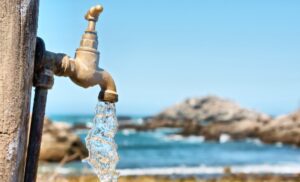Water is vital. As much as our world stops when the power goes out, the prospect of no water is much more dramatic. Fortunately, you don’t need an expensive inverter and batteries to stockpile water.
“Water is very versatile and can last for a long time if stored responsibly,” says Chetan Mistry, Strategy and Marketing Manager at Xylem Africa. “How you store your water depends on its uses: potable water for drinking or cooking requires much stricter management than non-drinking water for washing or irrigation—water-borne diseases and parasites are among the most dangerous threats to human health. “But it’s not difficult to adopt basic water-management techniques, and everyone should look at some type of water storage, especially rainwater capture and water recycling systems. In a water-scarce country like South Africa, we mustn’t wait for the taps to dry. We should look after our water, and storing water is a good way to appreciate the most precious resource on our planet.” You can store water for emergencies or to lower utility costs. Yet some mistakes could ruin your efforts and even create health hazards. To help avoid such situations, Xylem Africa suggests the following tips when stockpiling water.Decide your needs
Do you need water to drink or cook? Do you need to keep your vegetable garden hydrated? Will a lack of water harm certain operations in your business? Water serves many functions, so determine your priorities and stockpile accordingly. Some people can do with a few jugs of drinkable water, while others may need large storage tanks of non-potable water suited for other jobs. The consensus is that an adult drinks around 3 litres of water a day, and you can double that to cover cooking needs per person. If you are a business, monitor water consumption for a month to see where the most demand exists.Water sources
There are different ways to access water. The simplest is stockpiling water from a municipal supply or buying bottled water. Capturing rainwater is a very affordable way to capture large amounts of water, and some are fortunate to have access to boreholes. You can also recycle water from your premises, such as water used for washing dishes or clothes, reusing it for irrigation, refiling cisterns, or outdoor washing. With the appropriate filters, you can make contaminated water drinkable. But avoid water contaminated with chemicals (such as water mixed with non-biodegradable soap) or bio-matter (such as food waste or faeces).Water’s shelflife
In theory, you could store water indefinitely. But this requires starting with clean water, keeping it away from light and chemicals, using sterilised containers, and avoiding future contamination. It’s hard to do in practice—especially if the water is for drinking. Consider rotating water stockpiles every six months, and look at decontamination options such as filters, UV light or controlled quantities of chlorine. Don’t assume that water with no taste or odour is safe: certain diseases (cholera) and chemicals (heavy metals) can linger in water without giving hints of their presence.Maintenance
Many of these tips include maintenance, but it’s worth emphasising. Leaving water infrastructure to fend for itself will create disease. There is no starker example than the recent cholera outbreaks, resulting from poorly-maintained treatment sites.And what applies to towns and cities also applies to individuals: poorly-maintained containers, pipes, and filters will encourage bacterial and parasitic growths that are very dangerous to humans—sometimes even without directly consuming the water.








